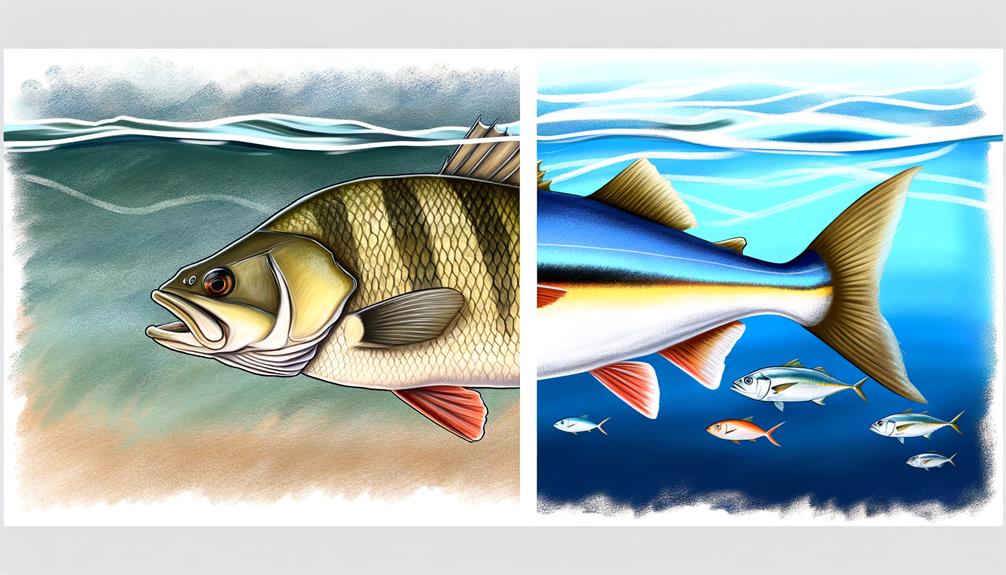The dichotomy between freshwater and saltwater fish presents a captivating topic of discussion, one that delves into the heart of biological and ecological adaptation. The differences span across various domains, including their respective habitats, physiological variations, salinity tolerance, size distinctions, species-specific adaptations, dietary preferences, and even their individual impacts on human consumption and health.
This discussion invites further exploration into the distinctive survival mechanisms of these species and the ways in which they have adapted to their unique aquatic environments. What could we uncover when we compare these two groups more closely?
Key Takeaways
- Freshwater and saltwater fish differ in habitat, with the former inhabiting rivers and lakes, while the latter thrive in seas and oceans.
- The water processing mechanisms and adaptive body structures of these fish vary, aiding their survival in diverse salinity and temperature ranges.
- Freshwater and saltwater fish exhibit size variations and growth rates, influenced by their respective environments and feeding mechanisms.
- Species-specific adaptations and diet are distinctive, with freshwater fish eating insects and algae, while saltwater fish consume crustaceans and plankton.
Understanding Freshwater and Saltwater Habitats
Diving into the exploration of freshwater and saltwater habitats, it is crucial to understand that freshwater fish primarily inhabit rivers, lakes, and streams, while their saltwater counterparts predominantly reside in the vast expanses of seas and oceans. The geographical distribution and ecological diversity of these habitats immensely influence the evolution, diversity, and survival strategies of these aquatic species.
Saltwater, which covers the majority of Earth's surface, offers a vast continuous habitat for marine life, with tropical waters exhibiting higher fish diversity. Evolution of saltwater fish originated in these vast oceans, leading to specific adaptations to conserve water and prevent excessive salt intake. This environment fosters a widespread species distribution and a high level of genetic exchange, promoting a rich biodiversity.
Contrastingly, freshwater habitats are more isolated, scattered across the globe in the form of rivers, lakes, and streams. This isolation results in a unique evolutionary path for freshwater fish, enabling rapid speciation and fostering diverse species. Despite their fragmented distribution, freshwater habitats harbor a significant portion of the world's fish species, showcasing the resilience and adaptability of life in these diverse ecosystems.
Anatomy and Physiology Variations
The anatomical and physiological differences between freshwater and saltwater fish are primarily driven by the distinct environmental challenges they face.
Key variations are found in their water processing mechanisms, gill structures, and overall body adaptations that facilitate survival in their respective habitats.
This discussion will focus on these variations, providing a detailed analysis of their functional implications and evolutionary significance.
Water Processing Mechanisms
In order to survive in their respective environments, freshwater and saltwater fish have evolved unique and efficient water processing mechanisms, exhibiting significant variations in their anatomy and physiology. This adaptation is vital for their survival, as it ensures an adequate balance of essential salts within their bodies.
- Freshwater fish have specialized kidneys that process water and maintain salt balance, allowing them to thrive in environments with lower salt concentrations.
- Saltwater fish, in contrast, combat the loss of body fluids through their gills due to osmosis by consuming saltwater and excreting the excess salts.
- Both types of fish have developed unique mechanisms to prevent impurities from entering their bodies, with freshwater fish absorbing and retaining salt to adapt to their environment.
Differences in Gills
While examining the anatomical and physiological variations between freshwater and saltwater fish, a crucial distinction emerges in the structure and functionality of their gills.
The gills of freshwater fish are specifically designed to prevent impurities from entering their bodies, assisting in the efficient processing of water to maintain internal balance.
By contrast, the gills of saltwater fish play a role in osmosis, causing them to lose body fluids. To counteract this, they intake saline water via their gills, striving to sustain osmotic equilibrium.
It's noteworthy that the kidneys of freshwater fish are larger and more efficient in regulating water intake than their saltwater counterparts, further highlighting the significant differences in gill structure and function between these two groups.
Adaptive Body Structures
Adaptations in body structures, notably in scale anatomy and kidney function, have significantly contributed to the survival and thriving of both freshwater and saltwater fish in their unique aquatic environments. These adaptive body structures have evolved over time, aiding in the adjustment to diverse aquatic habitats and the regulation of the concentration of salt within their bodies.
- Freshwater fish possess broad, strong scales that provide protection and support, whereas saltwater fish may have smaller scales for increased flexibility.
- Freshwater fish kidneys have evolved to expertly regulate salt concentration, accommodating the changing conditions of their environment.
- Saltwater fish have developed specialized teeth such as pharyngeal, palatine, and vomerine for unique feeding requirements in their habitats, indicating the remarkable adaptability of these species.
Temperature and Salinity Tolerance
The tolerance levels for temperature and salinity markedly differ between freshwater and saltwater fish, significantly influencing their habitat preferences, distribution, and behaviors. Freshwater fish thrive in a temperature range of 5 to 24 degrees Celsius, and their preferred environments have salinity levels less than 0.05%. Conversely, saltwater fish are adapted to a broad spectrum of temperatures and can survive in seas and oceans with salinity over 35 ppt.
These differential tolerances have shaped the respective ecosystems of freshwater and saltwater fish. Freshwater fish, with their preference for stable salinity levels and temperature, are mainly found in rivers, lakes, and streams. On the other hand, saltwater fish, adapted to constant changes in salinity and temperature, inhabit diverse regions including tropical seas, coral reefs, and deep sea environments.
| Freshwater Fish | Saltwater Fish | |
|---|---|---|
| Temperature Range (°C) | 5 – 24 | Variable |
| Salinity Levels | < 0.05% | > 35 ppt |
| Typical Habitats | Rivers, Lakes, Streams | Tropical Seas, Coral Reefs, Deep Sea |
| Adaptive Traits | Stable Salinity and Temperature | Changeable Salinity and Temperature |
Understanding these differences in temperature and salinity tolerance is crucial in the study and conservation of these species, and their respective habitats. It also offers insight into how they have evolved to conquer their specific environments.
Freshwater Vs Saltwater Fish Sizes

In the comparison of freshwater and saltwater fish, size variation emerges as a significant factor, with species demonstrating a broad spectrum of sizes from the minuscule Marshall Islands goby to the colossal whale shark.
This leads to a pertinent discussion on the growth rates of both freshwater and saltwater species, which can be influenced by various environmental and genetic factors.
Furthermore, common misconceptions regarding the sizes of these aquatic creatures will be examined, shedding light on often overlooked intricacies in the comparative study of freshwater and saltwater fish.
Size Variation Factors
Often, the size variations in both freshwater and saltwater fish species can be attributed to factors such as their habitat, feeding mechanisms, and structural adaptations. For instance, freshwater fish like the hefty white sturgeon have evolved to efficiently sense food, making them larger than many of their freshwater counterparts. Conversely, saltwater fish, such as the colossal marlin, have diverse mouth structures for feeding, influencing their size.
To further illustrate, consider these three points:
- The white sturgeon, a freshwater fish, can weigh up to a hefty 400 pounds.
- The massive marlin, a saltwater fish, showcases the potential enormity of marine life with its staggering weight of over 21.5 tonnes.
- These size variations reflect the influences of habitat and feeding mechanisms, highlighting the complex interplay of environmental and biological factors in fish development.
Growth Rates Comparison
Building upon the exploration of size variations, a comparative analysis of growth rates reveals that freshwater fish usually grow at slower rates than their saltwater counterparts, largely due to differences in size, metabolic rates, and environmental conditions. Saltwater fish like tuna and marlin, for instance, exhibit rapid growth rates due to favorable environmental conditions such as abundant food supply and optimal water temperatures.
On the contrary, freshwater species like trout and catfish may require several years to reach their full potential size, reflecting their slower metabolic rates. These growth rate variations are significant as they directly influence the sizes freshwater and saltwater fish achieve in adulthood, thus highlighting the biological and ecological uniqueness of each group.
Common Size Misconceptions
Contrary to common misconceptions, the size disparities between freshwater and saltwater fish are indeed substantial, with freshwater species generally being smaller in comparison to their saltwater counterparts. Even though the largest freshwater fish, the white sturgeon, can weigh up to 400 pounds, it pales in comparison to saltwater giants like the tuna and marlin, which can weigh over 21.5 tonnes.
- Freshwater fish range from tiny Philippine gobbies to the substantial white sturgeons.
- The smallest saltwater fish, the Marshall Islands goby, still falls short when compared to the largest saltwater fish, the whale shark, which averages 12.5 meters in length.
- Understanding these size differences is essential for proper identification and species protection efforts.
The importance of debunking these size misconceptions cannot be stressed enough.
Species Specific Adaptations

Delving into species-specific adaptations, it becomes evident that both freshwater and saltwater fish have evolved distinctive features and behaviors to survive and thrive in their respective habitats. Catfish, a typical freshwater species, have developed whisker-like barbels as a feeding adaptation. These barbels act as sensors, enabling catfish to detect food in often murky freshwater environments. Similarly, paddlefish, another freshwater species, have unique snouts designed to stir up bottom-dwelling organisms, facilitating their feeding process.
Contrastingly, saltwater species like the swordfish have developed elongated bills, not merely for combative defense, but also as a significant feeding adaptation. These bills are used to stun their prey before consumption, optimizing their feeding efficiency. Another intriguing example is the goosefish, which uses an enticing appendage to attract prey in the vast expanses of the ocean. Moreover, many saltwater fish have evolved complex mouth structures, such as pharyngeal, palatine, and vomerine teeth. These adaptations reflect the diversity of diets and feeding strategies, helping the species to effectively exploit their saltwater environments.
Each of these adaptations underlines the incredible ability of aquatic species to evolve and optimize their survival strategies within their specific habitats.
Diet and Predation Differences
Examining the dietary preferences and predation differences, it becomes apparent that freshwater and saltwater fish have remarkably distinct feeding habits and defense mechanisms, shaped by the unique characteristics and demands of their respective habitats.
Freshwater fish, for instance, primarily consume insects, algae, and smaller fish. However, the diet of saltwater fish is predominantly comprised of crustaceans, plankton, and larger fish, requiring a broader range of foraging strategies and specialized adaptations.
In terms of predation, freshwater fish face threats mainly from birds, mammals, and larger fish. These fish have developed camouflage abilities and hiding behaviors to counteract these threats, especially in murky waters. On the other hand, saltwater fish encounter predators such as sharks, marine mammals, and larger predatory fish. They rely more on speed and agility for their survival in the vast, open ocean environments.
- Freshwater fish diet: insects, algae, and smaller fish.
- Saltwater fish diet: crustaceans, plankton, and larger fish.
- Predation differences: Freshwater fish use camouflage and hiding, saltwater fish depend on speed and agility.
These dietary and predation adaptations have been shaped by the unique ecological pressures in freshwater and marine habitats, demonstrating how fish species have evolved to thrive in their specific environment.
Impact on Human Consumption and Health

The impact on human health and consumption patterns of freshwater and saltwater fish is marked by distinct nutritional qualities and flavor profiles, shaped by their unique ecological habitats. Freshwater fish, such as salmon and bass, are replete with higher levels of calcium and certain fatty acids, vital for maintaining bone health and optimal heart function, respectively. Moreover, these fish offer elevated folate and vitamin A content, enhancing the nutritional value of dishes they are incorporated in.
Conversely, saltwater fish present a pronounced salty taste, a direct influence of their marine environment, which appeals to those who appreciate a briny flavor in seafood dishes. These fish offer similar sodium content to their freshwater counterparts, making them equally viable protein choices for balanced diets.
The diverse species available in freshwater ecosystems, including trout and catfish, contribute to a wider variety of nutritious seafood options, augmenting the potential for diverse consumption patterns. Thus, both freshwater and saltwater fish play an instrumental role in shaping dietary habits, with their unique attributes offering different health benefits and taste experiences.
Frequently Asked Questions
What Is the Difference Between Saltwater and Freshwater Fish?
Freshwater and saltwater fish differ mainly in their gill functionality and osmoregulation process. Freshwater fish retain salt, while saltwater fish consume saltwater for survival, showcasing their adaptation to distinct aquatic environments.
How Are Fish Adapted to Freshwater Versus Saltwater Habitats?
Freshwater fish exhibit gill adaptations and osmoregulation mechanisms that efficiently retain salts and excrete excess water. Conversely, saltwater fish consume saltwater, excreting concentrated salts while maintaining water balance, demonstrating unique biological adaptability to their respective habitats.
What Is the Difference Between Freshwater and Saltwater Habitats?
Freshwater and saltwater habitats differ significantly in their aquatic ecosystems. Freshwater habitats, while smaller and more isolated, tend to harbor greater habitat biodiversity due to species' specific adaptations to diverse environmental conditions.
How Do the Kidneys Function Differently in Freshwater and Saltwater Fish?
Kidney structures in freshwater and saltwater fish differ significantly, facilitating unique osmoregulation processes. Freshwater fish kidneys conserve salts, excreting excess water, while saltwater fish kidneys conserve water, expelling surplus salts to maintain internal balance.
Conclusion
In conclusion, the distinction between freshwater and saltwater fish is marked by varied adaptations to their corresponding habitats, physiological differences, and tolerance to salinity and temperature.
These variations influence their size, species-specific adaptations, diet, predation practices, and ultimately, their impact on human consumption and health.
As a fascinating testament to the power of evolution and adaptation, these differences underscore the complexity, diversity, and resilience of life under the water's surface.


